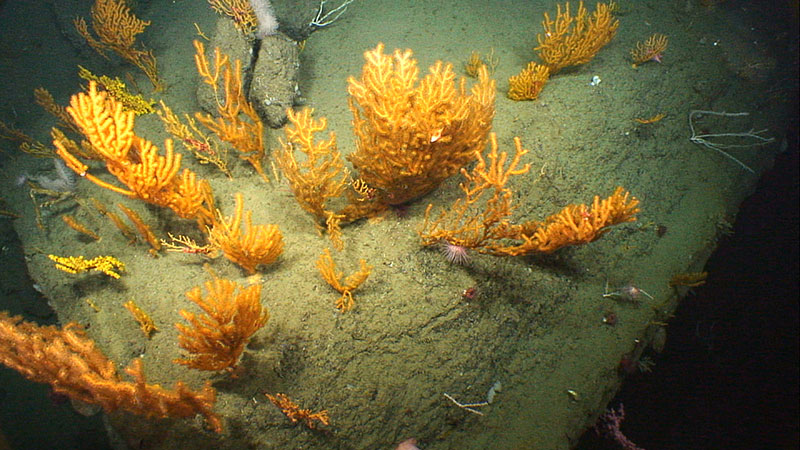The third dive took place on the western wall of Oceanographer Canyon and was characterized by high diversity and abundances of corals. While descending to the bottom, several salps were observed suspended in the water column. The remotely operated vehicle (ROV) reached the seafloor at a depth of 1,236 meters. Once on the bottom, there were rocks of various sizes, all with some level of sediment drape. These rocks had very angular faces, with no obvious signs of erosion. Roots from an Acanella coral extended down a rock face, much like tree roots, which had not been observed by the scientists before. Many quill worms were present on the soft sediment. At 1,217 meters, we observed a squid eating a midwater fish. Several large rocks with steep faces were the primary features examined for the remainder of the dive. Hard substrates were populated by several large Anthothela, Paramuricea with ophiuroid associates and various sponges, including yellow sponges and other hexactinellids. Around 1,210 meters, coral abundance increased dramatically and time was spent imaging corals, their associates, and rock-associated fauna. Two black corals, Parantipathes and cf. Bathypathes, were imaged with their associates, chirostylid squat lobsters and scaleworms. At 1,204 meters, a different type of shrimp, grey/purple in color, was resting on the rock surface near an Acanella bamboo coral and cup corals. A t-shaped echiuran proboscis was imaged retracting into the sediment nearby; this animal has not been observed on any of the dives thus far, including dives on the first leg of this expedition. At ~ 1,150 meters, there was a distinctive change in the geology to eroded and heavily sculpted mudstone. We found an unusual bacterial mat coating the seafloor in an area of collapsed soft sediment. There was no seafloor seepage noted throughout the dive, so the underlying source for bacterial production was not obvious but possibilities are numerous. The primary highlights from the dive were the high abundances of Paramuricea and bamboo corals and the range of sizes observed along the dive track, with the largest colonies appearing at the end of the dive. Overall, there was a north to south trend in current flow and many of the corals extended from the walls perpendicular to the southward flow, possibly to take advantage of the flow and associated food flux. It was a great dive overall.
